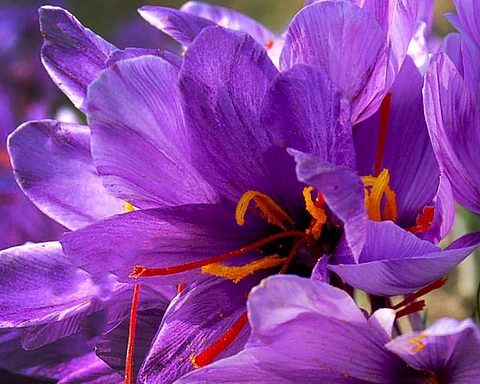

“Despite declining saffron yield in Pampore, a young farmer defies tradition to introduce crocus in North Kashmir”
According to Food and Agriculture Organization “Over 17,000 family farmers are stewards of this traditional crop in Kashmir with almost 9, 000 farm families from Pulwama consisting of about 66% from rural and 34% from peri-urban background. In general, the male population is observed to be more than female in all the saffron villages.”
But saffron cultivation has been facing many challenges and experts point to a complex web of factors behind its declining production such as decreased yields, inadequate irrigation, the impact of climate change, unpredictable weather patterns, urbanization, changes in soil nutrients and microbiome, and other environmental factors, leading to a significant decline in its production.
Climate Change and Urbanization
According to data from the Kashmir agriculture department, saffron production in Kashmir has declined by around 65% over the past two decades due to climate change, with production dropping from 15.95 tonnes in 1990 to just 2.6 tonnes in 2023-24, representing a significant loss in saffron yield.
Dr Rayees, a geographer, explains that the delicate saffron crocus requires specific conditions: a temperature range of 12°C to 15°C during the growing season. Climate change disrupts this balance, with rising temperatures delaying blooming and reducing saffron thread quality.
“Prolonged heat can stress the plant, reducing its capacity to produce high-quality saffron threads,” Dr Rayees notes. Showkat Nissar, a PhD scholar, adds that “Erratic weather patterns have made it increasingly difficult to predict and manage the saffron growing season.”
Environmental pollution compounds the problem. Cement factories near saffron fields release harmful gases that damage delicate flowers. Urbanization has dramatically reduced cultivation areas, with saffron land decreasing from 5,707 hectares in 1996 to 3,715 hectares in 2016 – a loss of nearly 2,000 hectares.
“Urbanization has brought many changes, but it is not all good for us. We are losing our traditional way of life and our valuable agricultural land,” says Abrar, a geography student from Pulwama.
Weather Vagaries and Irrigation
According to a study, prolonged periods of drought amidst the changing climatic patterns have caused significant concerns among saffron farmers. “Since the crop heavily relies on rainfall, insufficient precipitation has resulted in the region experiencing its lowest saffron productivity in the past three decades, the study says.”
Researchers like Showkat Nissar highlight the delicate water balance needed: “Saffron plants need a balanced amount of rain. Too much rain during flowering can cause diseases, while too little can affect flower development.”
A 60-year-old saffron grower laments, “We still rely on traditional methods of cultivation and harvesting… adulteration is a major threat to the reputation of Kashmiri saffron.”
A local farmer, Mohd Ashraf, shares his despair: “The fields are parched, the flowers are withering. It’s heartbreaking to see our livelihood slipping away.” He adds poignantly, “The decline of saffron is not just an economic loss, it is a cultural tragedy.”
To combat these challenges, farmers are exploring innovative techniques like aeroponics. Dr Rayees suggests this method offers precise control over temperature, water, and nutrient delivery, potentially safeguarding saffron production.
A senior PhD scholar of environmental science from Kashmir University, Ikhlaq Majeed, emphasizes the critical role of moisture in the various stages of saffron cultivation, particularly in the Karewa region with its lower water table. He also warns that excessive water can lead to waterlogging and fungal infections.
Hope Despite Challenges
Despite these challenges, some recent efforts provide hope. The National Saffron Mission, launched in 2010-11 by the Indian government, aims to revive saffron cultivation in Kashmir. With an investment of 4.1 billion rupees, the mission seeks to address challenges facing saffron farmers, including environmental issues, outdated farming techniques, and economic instability.
The mission includes introducing modern irrigation techniques, developing better infrastructure, promoting Kashmiri saffron as a premium international product, and training farmers in climate-smart agricultural practices.
Researchers are also exploring sustainable solutions to preserve this cultural heritage, including organic fertilizers, crop rotation, and innovative techniques like aeroponics. Local experts like Dr Rayees and researchers like Showkat Nissar emphasize the critical need to support farmers and adapt to changing environmental conditions.
Farmers like Bilal remain cautiously optimistic, recognizing saffron farming as both a livelihood and a cultural tradition. Despite the slow implementation of support schemes, there’s hope that with comprehensive government support, technological innovation, and sustainable practices, Kashmir can safeguard its golden saffron legacy for future generations.
Despite challenges, the Pulwama farmers continue to plough their fields with unwavering determination. Amidst these arduous circumstances, Mudasir’s venture to extend the saffron fields from Pampore to Baramulla offers a road map for the future.
—–
Have you liked the news article?